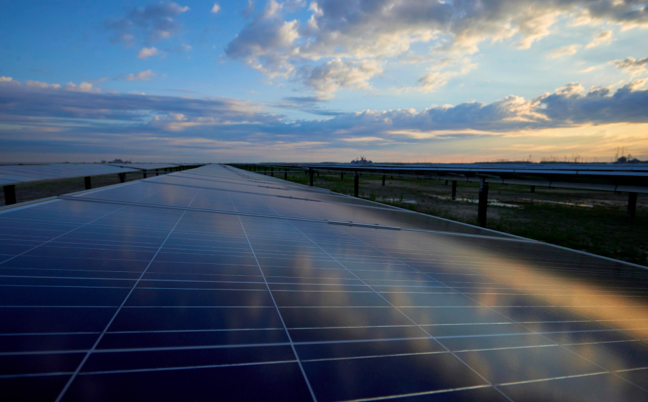Air and Climate
Globally as well as locally, mitigating and adapting to climate change is one of the central challenges of our time. GW was the first university in Washington, D.C. to join the American College and University Presidents’ Climate Commitment (ACUPCC) in 2008. In 2010, the university published its Climate Action Plan in which it committed to becoming carbon neutral across all three scopes of greenhouse gas (GHG) emissions by 2040. In 2020, that commitment was accelerated to 2030.
In 2020, GW committed to accelerate its carbon neutrality timeline to at least 2030. We aspire to achieve carbon neutrality through limited use of carbon credits. In commemoration of GW’s bicentennial celebration in 2021, the university also aspires to remove all the greenhouse gas emissions the university has produced since its founding in 1821.
As part of the D.C. Department of Energy and Environment’s Solar for All program, George Washington University hosts solar panels on the rooftops of five campus buildings including Funger and Duquès halls, the Charles E. Smith Center, Monroe Hall and Hall of Government, Lisner Auditorium and the Media and Public Affairs Building. The panels are designed to have a capacity of 497 kWAC, with the clean energy generated by the system reducing greenhouse gas emissions equivalent to removing roughly 90 cars from the road each year they operate. GW also hosts solar thermal systems on the Foggy Bottom campus that heat water in residence halls including at 1957-59 E Street buildings, Building JJ, and Shekman Hall. On the Virginia Science and Technology Campus, GW features a solar walk—a small photovoltaic array over a walkway. These projects increase renewable energy production on campus and reduce electricity expenses at GW.
Highlights
Capital Partners Solar Project
Capital Partners Solar Project is an innovative renewable energy project that provides solar power for GW, American University and the George Washington University Hospital (GWUH). It is comprised of 53.5 megawatts (MW) of solar photovoltaic (PV) power.
This project demonstrates how large organizations in an urban setting can partner to significantly reduce their carbon footprints by purchasing offsite solar energy. Supplied by Duke Energy Renewables, the solar power helps all three institutions reduce their carbon footprint significantly, abating approximately 84,900 metric tons of carbon dioxide equivalent (MTCO2e) compared to conventional electricity. This is equivalent to taking roughly 17,900 cars off the road. In addition, the project will yield economic savings for each institution as the price of traditional power is expected to increase over the duration of the 20-year project contract.
Designed and facilitated by CustomerFirst Renewables (CFR), this project is a model for other urban institutions that want to meet their electricity needs using renewable energy. The groundbreaking for the first site located in Pasquotank County near Elizabeth City, NC took place in summer 2014 and the project began to deliver electricity in full by the beginning of 2016.
Green Buildings
GW has launched four large energy and water efficiency projects known as the Eco-Building Program.
The Eco-Building Program has been installing more modern and efficient equipment in selected buildings to reduce energy and water use, operating costs, and greenhouse gas emissions. These initiatives include: more efficient use of potable water; upgrading old HVAC equipment like boiler controls, chillers, and air-handling units; adding new HVAC equipment like variable-speed drives and variable-air-volume boxes; retro-commissioning older HVAC equipment; and installing more energy-efficient lighting and controls.
These projects are being developed using a holistic view of savings opportunities across campus. Phase 1 focused on the Gelman Library block of buildings. Phase 2 focused on the Lisner Hall block of buildings. Phase 3 focused on Rice Hall, Marvin Center, and Funger and Duquès Halls. Phase 4, which is about to begin, will include four buildings at the Virginia Science and Technology Campus.
LEED Certified Buildings
GW’s focus on sustainable buildings began in 2007 when the university pledged that all new buildings would meet the LEED Silver standard or better. Ten years later, GW has made good on the commitment: There are thirteen LEED-certified buildings and four LEED certified interiors on its campuses, including thirteen Gold and one Platinum level. These projects incorporate energy- and water efficient equipment, green roofs and rainwater reuse systems, among other sustainable features.
- LEED Platinum Certified
-
Milken Institute School of Public Health
- LEED Gold Certified
-
South Hall
West Hall
Lafayette Hall
Smith Center
Ames Hall
2013 H St NW
Law Clinic
GW Museum
Science and Engineering Hall
District House Residence Hall
Ross Hall
Corcoran Hall
- LEED Silver Certified
-
Museum Conservation Center
Law Learning Center and G Street Garage
1922 F St
Charged Up Solar Design Competition
The GW Office of Sustainability invited student innovators to participate in a design competition for a campus solar charging station sponsored by the GW Division of Operations to raise awareness around renewable energy on campus.
The winning project, called Marisol, was designed, built, and installed by a team of interdisciplinary undergratuate students. The design, which incorporated themes of culture, artistry, and engineering, provides an opportunity for students to engage with renewable energy, first-hand, as they use it to charge their personal devices outside.
Rooftop Solar
The George Washington University is providing rooftop space on five campus buildings for solar photovoltaic panels that will increase solar electricity in Washington, D.C. The panels are designed to have a capacity of 497 kWAC (579 kWDC), with the clean energy generated by the system reducing greenhouse gas emissions equivalent to removing roughly 100 cars from the road each year they operate.
Solar panels have been installed on the rooftops of five Foggy Bottom Campus buildings: Funger and Duquès Halls, the Charles E. Smith Center, Monroe Hall and Hall of Government, Lisner Auditorium and the Media and Public Affairs Building. The project is part of a larger university commitment to reduce its carbon footprint through energy efficiency initiatives and clean energy purchases. Specifically, this project will increase renewable energy production on campus and reduce electricity expenses at GW.
.png)




